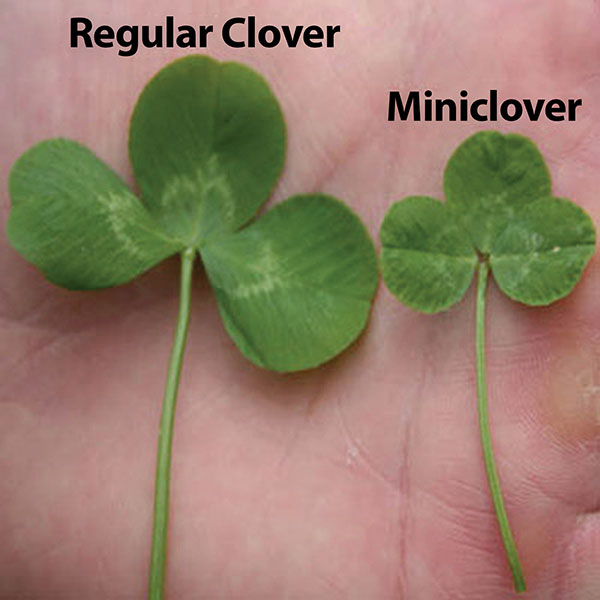Miniclover is drought-tolerant, simple, stunning and sustainable with low-to-no maintenance
(Joan Casanova) That lush, green lawn most strive for is struggling to survive as our climate experiences “weather whiplash,” meaning abrupt swings in weather conditions from one extreme to another. Last season, drought conditions were so dire in California billboards shouted, “Brown is the New Green.” This season, despite early, extreme flooding in California, evidence suggests the length and depth of droughts will increase in upcoming years, becoming more frequent and severe.
Outdoor water usage is still astronomical, synthetic chemical use is ever-present and fuel-guzzling lawn blowers and mowers sing all summer. Traditional lawn maintenance is expensive, unnatural, untenable and increases greenhouse gasses, wastes water, pollutes ecosystems and reduces biodiversity.
 Average American families use 320 gallons of water daily, about 30% outdoors, with more than half devoted to watering lawns and gardens, according to the EPA. Nationwide, landscape irrigation is estimated at almost one-third of all residential water usage, totaling nearly 9 billion gallons daily.
Average American families use 320 gallons of water daily, about 30% outdoors, with more than half devoted to watering lawns and gardens, according to the EPA. Nationwide, landscape irrigation is estimated at almost one-third of all residential water usage, totaling nearly 9 billion gallons daily.
Gas-powered lawn mowers spew pollutants that can cause planet-warming gases, contributing to climate crisis and drought. According to the EPA, gas-powered lawn equipment releases more than 22 million tons of CO2 emissions and estimates over 17 million gallons of gasoline are spilled refueling lawn equipment; that’s more than all oil spilled by Exxon Valdez.
There are many issues causing harm to environmental health, from the ridiculous, like billionaires taking 17-minute flights in private jets, producing 2 tons of CO2 emissions, to everyday lawn care wasting staggering amounts of water for aesthetics while polluting the environment through run-off and toxic emissions.
Cash rebates, up to $5,000, are being offered to some for the removal of grass lawns. To get the rebate, other water-efficient options must be put in place. It’s time to take a page from the past; sowing clover seed can create a great-looking, water-efficient, sustainable lawn. Decades ago, clover was standard in lawn seed mixes. Then agricultural chemical companies created herbicides to rid lawns of broadleaf plants, killing everything but grass, clovers included, branding them weeds.
“Today, clover is making a comeback,” said Troy Hake, president and owner of Outsidepride.com, offering drought-tolerant grasses, clovers, wildflower seeds and more. “Tik Tok’s #cloverlawn has over 65 million views, evidencing it’s time for sustainable options, like adding ‘miniclover’ or replacing lawns with it. Miniclover (trifolium repens), is one-third to half the size of white Dutch clover, only grows 4-6 inches and produces a thick, carpet-like look that blends well with turf. Less expensive than grass seed, it’s a natural solution for self-sustaining, low-maintenance lawns that look beautiful and help eliminate the need for fertilizers, herbicides, pesticides and weekly mowing. It’s healthier for people, pets, soil and waterways. You can’t go wrong with it.”
There’s nothing you can do about those 17-minute private jet flights. However, anyone with a lawn can add-in miniclover and redefine what sustainable lawns and responsible lawn care looks like. Sales of miniclover rose dramatically last season, surely an indicator that this lawn renovation trend was well-received and continues to grow.
Benefits:
Nitrogen fixer. Miniclover takes nitrogen from the air and “fixes” it in soil, eliminating the need to apply nitrogen, keeping lawns green and growing while adding natural nitrogen to surrounding soil.
Drought tolerant. Miniclover is drought-tolerant and can stay green all summer with minimal watering.
Deters bugs. Grubs that feed on grass roots will not eat miniclover, and adult beetles and bugs are deterred from laying eggs in it.
Crowds out weeds. Miniclover is evenly dispersed via stolons (stems grow horizontally along the ground), crowding out weeds, preventing new weeds and controlling erosion.
Low-to-no maintenance. You can mow miniclover – the more it’s cut, the smaller the leaf size – or let it grow. Miniclover only blooms once in summer, providing bees with nectar, or mowing will prevent blooming.
Thrives in sun to partial shade. Miniclover does well in partial shade that receives some direct sunshine daily.
Stands up to soil and subsoil compaction.
Immune to “dog patches.” Dog urine discolors lawns, but miniclover stays green and lush.
Feels soft and springy on bare feet and looks like ordered whimsy.
So... what’s not to like?
For other drought-tolerant options, visit Outsidepride.com.
Photos courtesy of OutsidePride.com
Source: OutsidePride.com







